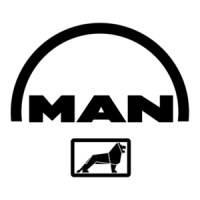reached the standby filter chamber is brought on
line simultaneously as the dirty one is isolated by
means of the change-over valve. After venting, the
dirty element can be removed, cleaned and refilled
to be the standby filter chamber.
Fuel injection equipment
Each cylinder unit has its own set of injection equip-
ment comprising injection pump unit, high-pressure
pipe and injection valve.
The injection equipment and the distribution supply
pipes are housed in a fully enclosed compartment
thus minimizing heat losses from the preheated fuel.
This arrangement reduces external surface temper-
atures and the risk of fire caused by fuel leakage.
The injection pump units are with integrated roller
guide directly above the camshaft.
The fuel quantity injected into each cylinder unit is
adjusted by means of the governor, which main-
tains the engine speed at the preset value by a con-
tinuous positioning of the fuel pump racks, via a
common regulating shaft and spring-loaded link-
ages for each pump.
The injection valve is for "deep" building-in to the
centre of the cylinder head.
The injection oil is supplied from the injection pump
to the injection valve via a double-walled pressure
pipe installed in a bore in the cylinder head.
This bore has an external connection to lead the
leak oil from the injection valve and high-pressure
pipe to the waste oil system, through the double
walled pressure pipe.
A bore in the cylinder head vents the space below
the bottom rubber sealing ring on the injection
valve, thus preventing any pressure build-up due to
gas leakage, but also unveiling any malfunction of
the bottom rubber sealing ring due to leak oil.
Waste oil system
Clean leak oil from the fuel injection valves, fuel
injection pumps and high-pressure pipes, is led to
the fuel leakage alarm unit, from which it is drained
into the clean leak fuel oil tank.
The leakage alarm unit consists of a box, with a
float switch for level monitoring. In case of a leak-
age, larger than normal, the float switch will initiate
an alarm. The supply fuel oil to the engine is led
through the leakage alarm unit in order to keep this
heated up, thereby ensuring free drainage passage
even for high-viscous waste/leak oil.
Waste and leak oil from the hot box is drained into
the sludge tank.
Clean leak fuel tank
Clean leak fuel is drained by gravity from the engine.
The fuel should be collected in a separate clean
leak fuel tank, from where it can be pumped to the
service tank and reused without separation. The
pipes from the engine to the clean leak fuel tank
should be arranged continuously sloping. The tank
and the pipes must be heated and insulated, unless
the installation is designed for operation exclusively
on MDO/MGO.
The leak fuel piping should be fully closed to pre-
vent dirt from entering the system.
Sludge tank
In normal operation no fuel should leak out from the
components of the fuel system. In connection with
maintenance, or due to unforeseen leaks, fuel or
water may spill in the hot box of the engine. The
spilled liquids are collected and drained by gravity
from the engine through the dirty fuel connection.
Waste and leak oil from the hot box is drained into
the sludge tank.
The tank and the pipes must be heated and insula-
ted, unless the installation is designed for operation
exclusively on MDO/MGO.
Data
For pump capacities, see "
D 10 05 0 List of capaci-
ties
"
Fuel oil consumption for emissions standard is sta-
ted in "
B 11 01 0 Fuel oil consumption for emis-
sions standard
"
Set points and operating levels for temperature and
pressure are stated in "
B 19 00 0 operation data &
set points
"
MAN Diesel & Turbo
B 11 00 0
Internal fuel oil system
3700163-4.1
Page 2 (2)
L27/38S, L27/38
2016.02.05 - Drain split

